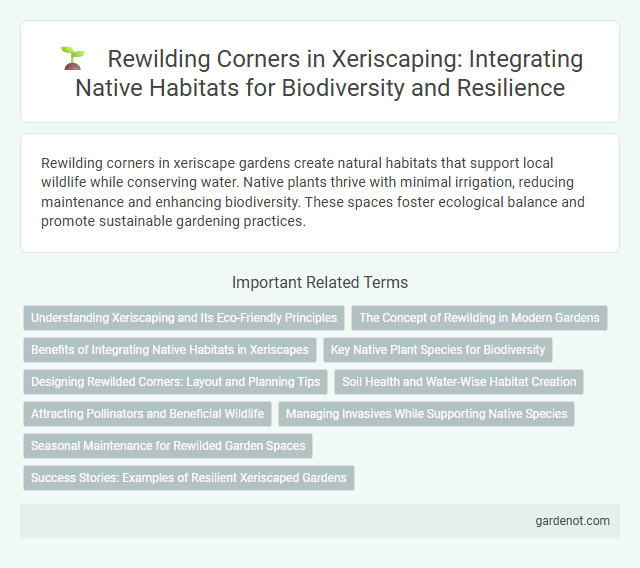Rewilding corners in xeriscape gardens create natural habitats that support local wildlife while conserving water. Native plants thrive with minimal irrigation, reducing maintenance and enhancing biodiversity. These spaces foster ecological balance and promote sustainable gardening practices.
Understanding Xeriscaping and Its Eco-Friendly Principles
Xeriscaping conserves water by incorporating drought-tolerant plants native to arid environments, reducing the need for supplemental irrigation. Its eco-friendly principles prioritize soil health through organic mulch and minimal disturbance, promoting natural water retention and biodiversity. This sustainable landscaping method supports local ecosystems by encouraging native flora and fauna in rewilding corners.
The Concept of Rewilding in Modern Gardens
Rewilding in modern gardens promotes restoring native ecosystems by reducing lawn areas and introducing indigenous plants, which support biodiversity and natural pollinators. This sustainable approach emphasizes water conservation and soil health, aligning with xeriscape principles to create resilient landscapes requiring minimal irrigation. Incorporating rewilded zones enhances local wildlife habitats while reducing maintenance and resource consumption.
Benefits of Integrating Native Habitats in Xeriscapes
Integrating native habitats into xeriscapes enhances biodiversity by providing essential food and shelter for local wildlife such as pollinators, birds, and beneficial insects. This approach promotes water conservation through plants adapted to the regional climate, reducing irrigation needs and supporting sustainable landscaping. Native habitats also improve soil health and resilience, contributing to a balanced ecosystem within urban and suburban environments.
Key Native Plant Species for Biodiversity
Rewilding corners enhance biodiversity by incorporating key native plant species such as Echinacea purpurea (purple coneflower), Asclepias tuberosa (butterfly weed), and Solidago spp. (goldenrod). These drought-tolerant plants support local pollinators, birds, and beneficial insects, promoting ecological balance in xeriscape landscapes. Strategically including these species optimizes water conservation while sustaining vital habitats for native wildlife.
Designing Rewilded Corners: Layout and Planning Tips
Designing rewilded corners in xeriscape landscapes involves selecting native, drought-tolerant plants that thrive with minimal irrigation while enhancing biodiversity. Incorporate varied plant heights and textures to create natural habitats for pollinators and wildlife, ensuring soil health through mulching and erosion control techniques. Strategic layout includes grouping plants by water needs and sun exposure, optimizing resource efficiency and ecological balance.
Soil Health and Water-Wise Habitat Creation
Rewilding corners in xeriscape design enhance soil health by promoting native plant growth that supports microbial diversity and natural nutrient cycling. These areas conserve water by utilizing drought-tolerant species that reduce irrigation needs, creating a water-wise habitat optimized for local wildlife. Integrating organic mulch and minimal disturbance techniques further improves soil structure and moisture retention, fostering a sustainable ecosystem.
Attracting Pollinators and Beneficial Wildlife
The rewilding corner in xeriscape gardens is designed to attract pollinators such as bees, butterflies, and hummingbirds by planting native, drought-tolerant flowering plants rich in nectar and pollen. Incorporating diverse species like coneflowers, milkweed, and goldenrod supports beneficial insects, birds, and other wildlife that promote natural pest control and ecosystem balance. This habitat enhances biodiversity while reducing water usage, contributing to sustainable landscaping practices.
Managing Invasives While Supporting Native Species
Rewilding corners in xeriscape gardens require vigilant management of invasive species such as kudzu and purple loosestrife, which threaten native plants like milkweed and goldenrod. Employing targeted removal techniques alongside planting robust native species fosters biodiversity and soil health. Supporting native pollinators like bees and butterflies is critical for ecosystem balance and resilience in water-efficient landscapes.
Seasonal Maintenance for Rewilded Garden Spaces
Seasonal maintenance in rewilded garden spaces emphasizes minimal intervention to support native flora and fauna while promoting ecological balance. Tasks include selective pruning, removal of invasive species, and monitoring soil health to sustain biodiversity through changing seasons. Ensuring native plants thrive reduces water usage and enhances habitat resilience within xeriscape designs.
Success Stories: Examples of Resilient Xeriscaped Gardens
Resilient xeriscaped gardens demonstrate the success of rewilding corners by thriving with native drought-tolerant plants such as desert marigold, yucca, and agave, which significantly reduce water consumption while enhancing biodiversity. Examples like the Phoenix Xeriscape Demonstration Garden showcase how thoughtful plant selection and soil conditioning create sustainable landscapes that withstand extreme heat and prolonged dry spells. These success stories highlight the importance of integrating local flora and regenerative techniques to create landscapes that are both ecologically balanced and aesthetically compelling.
Rewilding corner Infographic

 gardenot.com
gardenot.com